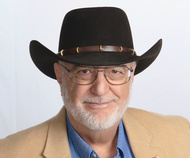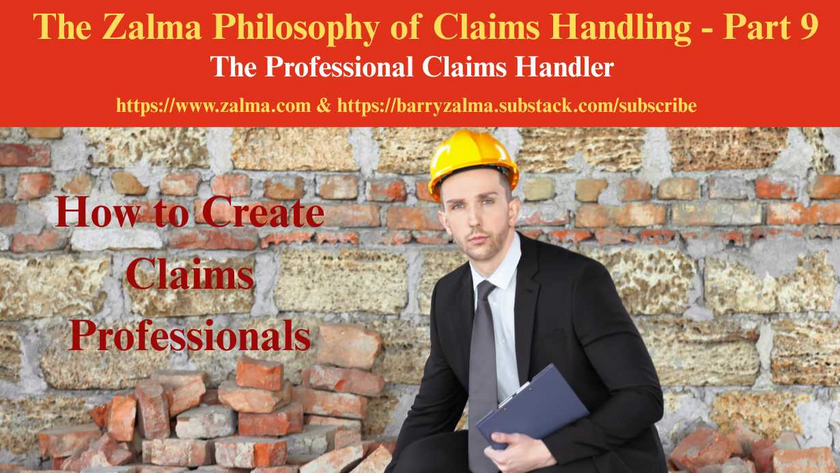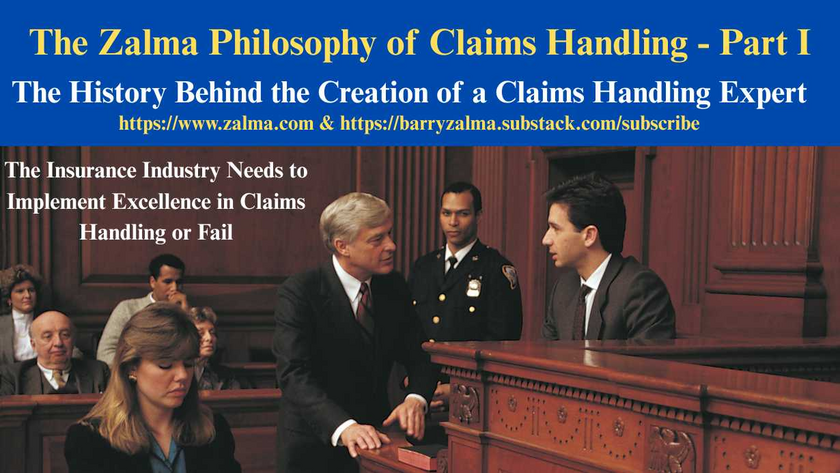
What is an Adjuster?
Barry Zalma
The Insurance Adjuster
What is an Adjuster?
Barry Zalma
Mar 6, 2024
Read the full article at https://lnkd.in/gvGdMBmF, see the full video at https://lnkd.in/g-vtt9C4 and at https://lnkd.in/gKWPN8if, and at https://zalma.com/blog plus more than 4700 posts.
Post 4748
The insurance adjuster is seldom, if ever, mentioned in a policy of insurance. The strict wording of the first party property policy sets the obligation to investigate and prove a claim on the insured.
Standard first party property insurance policies, based upon the more than a century old New York Standard Fire Insurance policy, contain conditions that require the insured to, within sixty days of the loss, submit a sworn proof of loss to prove to the insurer the facts and amount of loss.
In general, failure to file the proof within the time limited by the policy is fatal to an action upon it (White v. Home Mutual Ins. Co., 128 Cal. 131, 60 P. 666 (1900); Beasley v. Pacific Indem. Co., 200 Cal.App.2d 207, 19 Cal.Rptr. 299 (Cal. App. 1962).
Technically, if the wording of the policy was followed literally, the insurer could sit back, do nothing, and wait for the proof and if it wasn’t submitted within 60 days, deny the claim.
If the insured submits a timely proof of loss the insurer could either accept or reject the proof of loss.
If the insurer rejected the proof of loss the insured could either send a new one or give up and gain nothing from the claim. Filing suit on the policy would be difficult because the policy contract limited the right to sue to times after the proof of loss condition had been fulfilled.
Insureds and insurers were not happy with that system. It made it too difficult for a lay person to successfully present a claim. The system, as written into the standard fire policy seemed to run counter to the covenant of good faith and fair dealing that had been the basis of the insurance contract since, at least, 1766.
Most insurers recognized that their insureds were mostly incapable of complying with the strict mandate of the policy requiring a sworn proof of loss. Enforcement of the policy conditions made for unhappy insureds and the reputation of the insurer suffered.
In order to fulfill the covenant of good faith and fair dealing insurers created the insurance adjuster to fulfill its obligation to deal fairly and in good faith with the insured. The adjuster was created to assist the insured to comply with the material conditions of the policy, to thoroughly investigate the policy and the claim, to protect the interest of the insurer and protect against claims that were not due to a peril insured against or were false and fraudulent.
An Adjuster Is
An “adjuster” or “insurance adjuster” is, by statutory definition: “a person, co-partnership or corporation who undertakes to ascertain and report the actual loss to the subject-matter of insurance due to the hazard insured against. [California Insurance Code Section 14021]
A first party property adjuster is a specialist in adjusting claims brought by a person or entity insured against certain identified perils or risks of loss. The first party is the insured, the second party is the insurer, and the adjuster acts on behalf of the insurer.
Insurance companies create, by issuing an insurance policy, a contractual obligation to pay valid claims from those insured. To do so insurers understand that the person insured is not able to prove the cause and extent of loss without assistance. Therefore, insurers dispatch a person with special knowledge – the first party property adjuster – to separate fact from fiction, to establish cause and origin of the claimed loss, and determine sufficient information to enable the insurance company to determine the amounts necessary to indemnify the insured as the policy promised.
The adjuster is also present to distinguish the valid claim from a claim for which the insurance company is not liable under its policy, whether due to the terms and conditions of the policy or because of attempted fraud.
Most insurance policies issued by commercial – non-government supported – insurers accept substantial compliance with the policy conditions and require their adjusters to assist the insureds to fulfill the conditions.
As a general rule:
[W]hen an insurer gives its insured written notice of its desire that proof of loss under a policy of fire insurance be furnished and provides a suitable form for such proof, failure of the insured to file proof of loss within 60 days after receipt of such notice, or within any longer period specified in the notice, is an absolute defense to an action on the policy. [Stopani v. Allegany Co–op Ins. Co., 83 A.D.3d 1446, 920 N.Y.S.2d 559, 2011 N.Y. Slip Op. 2588 (N.Y. App. Div., 2011)]
Since the invention of the adjuster more than a century ago, the first person from the insurer that the insured meets when he or she suffers a first party property loss, is the adjuster. The claim adjuster was invented to smooth the claims process and be certain that the insured receives the indemnity promised and performs a complete and thorough investigation to avoid fraudulent claims.
How well the adjuster does his or her job will increase the reputation of the insurer and will not only keep the insured as a customer he or she will add additional customers by word of mouth.
Although most adjusters are not trained to be marketers their professionalism will act as the most effective marketing an insurer can receive better than any television ad.
Every modern claim adjuster should know that it is his or her duty to aid the insurer in its obligation to fulfill the promises made by the policy of insurance and assist the insured in presenting his or her claim to the insurer in accordance with the promises made by the insured to fulfill the conditions of the policy.
An adjuster’s duties to the insured do not arise from the insurance contract. The adjuster is not a party to the contract. He or she is an employee or agent of the insurer.
Every person in the business of insurance or who are insured by a policy of first party property insurance, must understand that an insurance adjuster is a person engaged in the business of insurance to investigate and resolve insurance claims. The first party property insurance adjuster limits his or her activities to the investigation and adjustment of first party property claims like fire, lightning, windstorm, hail, theft, etc.
The acts of an adjuster within the apparent scope of his or her authority are binding on the company without notice to the insured of limitations on his powers. [English and American Ins. Co. v. Swain Groves, Inc., Fla.App.1969, 218 So.2d 453; Old Republic Ins. Co. v. Von Onweller Const. Co., 239 So.2d 503 (Fla. App. 1970)]
The duty of the adjuster is to ascertain and determine the amount of any claim, loss or damage payable under an insurance contract, and/or effecting settlement of such claim, loss or damage.
The acts of an adjuster within the apparent scope of his or her authority are binding on the company. [Old Republic Ins. Co. v. Von Onweller Const. Co., 239 So.2d 503 (Fla. App. 2 Dist., 1970)]
ZALMA OPINION
The insurance adjuster is the only person acting on behalf of the insurance company an insured will meet in person. The adjuster, as far as an insured is concerned, is the insurance company. If the adjuster acts professionally, empathetically and helps the insured prove his or her claim is the best marketing tool an insurer can have. If the adjuster ignores the insured, is annoying or difficult to deal with the insured will never deal with that insurer again and may find a need to retain counsel to sue the insurer for damages and the tort of bad faith. [Adapted from The Compact Book of Adjusting Property Claims – 4th Edition available Available as a hardcover here. Available as a Kindle Book, paperback and hardcover at amazon.com.
(c) 2024 Barry Zalma & ClaimSchool, Inc.
Please tell your friends and colleagues about this blog and the videos and let them subscribe to the blog and the videos.
Subscribe to my substack at https://barryzalma.substack.com/publish/post/107007808
Go to Newsbreak.com https://www.newsbreak.com/@c/1653419?s=01
Go to X @bzalma; Go to the podcast Zalma On Insurance at; Go to Barry Zalma videos at Rumble.com at https://rumble.com/c/c-262921; Go to Barry Zalma on YouTube- https://www.youtube.com/channel/UCysiZklEtxZsSF9DfC0Expg.
Go to the Insurance Claims Library – https://lnkd.in/gwEYk
Please tell your friends and colleagues about this blog and the videos and let them subscribe to the blog and the videos.
Subscribe to my substack at https://lnkd.in/gcZKhG6g; Go to Newsbreak.com https://lnkd.in/g8azKc34
Go to X @bzalma; Go to Newsbreak.com; Go to the Insurance Claims Library – https://lnkd.in/gwEYk
Insurer’s Exclusion for Claims of Assault & Battery is Effective
Post 5250
Read the full article at https://lnkd.in/gBzt2vw9, see the video at https://lnkd.in/gEBBE-e6 and at https://lnkd.in/gk7EcVn9, and at https://zalma.com/blog plus more than 5250 posts.
Bar Fight With Security is an Excluded Assault & Battery
In The Cincinnati Specialty Underwriters Insurance Company v. Mainline Private Security, LLC, et al., Civil Action No. 24-3871, United States District Court, E.D. Pennsylvania (December 16, 2025) two violent attacks occurred in Philadelphia involving young men, Eric Pope (who died) and Rishabh Abhyankar (who suffered catastrophic injuries). Both incidents involved security guards provided by Mainline Private Security, LLC (“Mainline”) at local bars. The estates of the victims sued the attackers, the bars, and Mainline for negligence and assault/battery. The insurer exhausted a special limit and then denied defense or indemnity to Mainline Private Security.
INSURANCE COVERAGE
Mainline had purchased a commercial ...
Marine Insurer May Dispose of Vessel to Avoid Waste
Post 5249
Read the full article at https://lnkd.in/gfn_UHdp, see the video at https://lnkd.in/gDWVccnr and at https://lnkd.in/gv9nsBqk, and https://zalma.com/blog plus more than 5200 posts.
In Western World Insurance Company v. The Estate Of Shawn Arsenault, No. 25-cv-13413-PGL, United States District Court, D. Massachusetts (December 17, 2025) the USDC was asked to resolve a marine insurance dispute after the sinking of the F/V Seahorse, a commercial fishing vessel, off Cape Cod on June 8, 2025. The vessel’s owner and operator, Shawn Arsenault, died in the incident.
Western World Insurance Company issued a hull insurance policy for the vessel. With no personal representative yet appointed for the estate, the insurer cannot determine the proper payee for the insurance proceeds.
The insurer paid for the vessel’s recovery and removal, and the vessel is now with a salvage company, incurring substantial storage fees. The insurer determined the loss is covered under the ...
Marine Insurer May Dispose of Vessel to Avoid Waste
Post 5249
Read the full article at https://lnkd.in/gfn_UHdp, see the video at https://lnkd.in/gDWVccnr and at https://lnkd.in/gv9nsBqk, and https://zalma.com/blog plus more than 5200 posts.
In Western World Insurance Company v. The Estate Of Shawn Arsenault, No. 25-cv-13413-PGL, United States District Court, D. Massachusetts (December 17, 2025) the USDC was asked to resolve a marine insurance dispute after the sinking of the F/V Seahorse, a commercial fishing vessel, off Cape Cod on June 8, 2025. The vessel’s owner and operator, Shawn Arsenault, died in the incident.
Western World Insurance Company issued a hull insurance policy for the vessel. With no personal representative yet appointed for the estate, the insurer cannot determine the proper payee for the insurance proceeds.
The insurer paid for the vessel’s recovery and removal, and the vessel is now with a salvage company, incurring substantial storage fees. The insurer determined the loss is covered under the ...
Zalma’s Insurance Fraud Letter
Read the full article at https://lnkd.in/dG829BF6; see the video at https://lnkd.in/dyCggZMZ and at https://lnkd.in/d6a9QdDd.
ZIFL Volume 29, Issue 24
Subscribe to the e-mail Version of ZIFL, it’s Free! https://visitor.r20.constantcontact.com/manage/optin?v=001Gb86hroKqEYVdo-PWnMUkcitKvwMc3HNWiyrn6jw8ERzpnmgU_oNjTrm1U1YGZ7_ay4AZ7_mCLQBKsXokYWFyD_Xo_zMFYUMovVTCgTAs7liC1eR4LsDBrk2zBNDMBPp7Bq0VeAA-SNvk6xgrgl8dNR0BjCMTm_gE7bAycDEHwRXFAoyVjSABkXPPaG2Jb3SEvkeZXRXPDs%3D
Zalma’s Insurance Fraud Letter (ZIFL) continues its 29th year of publication dedicated to those involved in reducing the effect of insurance fraud. ZIFL is published 24 times a year by ClaimSchool and is written by Barry Zalma. It is provided FREE to anyone who visits the site at http://zalma.com/zalmas-insurance-fraud-letter-2/
Zalma’s Insurance Fraud Letter
Merry Christmas & Happy Hannukah
Read the following Articles from the December 15, 2025 issue:
Read the full 19 page issue of ZIFL at ...
The Professional Claims Handler
Post 5219
Posted on October 31, 2025 by Barry Zalma
An Insurance claims professionals should be a person who:
Can read and understand the insurance policies issued by the insurer.
Understands the promises made by the policy.
Understand their obligation, as an insurer’s claims staff, to fulfill the promises made.
Are competent investigators.
Have empathy and recognize the difference between empathy and sympathy.
Understand medicine relating to traumatic injuries and are sufficiently versed in tort law to deal with lawyers as equals.
Understand how to repair damage to real and personal property and the value of the repairs or the property.
Understand how to negotiate a fair and reasonable settlement with the insured that is fair and reasonable to both the insured and the insurer.
How to Create Claims Professionals
To avoid fraudulent claims, claims of breach of contract, bad faith, punitive damages, unresolved losses, and to make a profit, insurers ...

The History Behind the Creation of a Claims Handling Expert
The Insurance Industry Needs to Implement Excellence in Claims Handling or Fail
Post 5210
This is a change from my normal blog postings. It is my attempt. in more than one post, to explain the need for professional claims representatives who comply with the basic custom and practice of the insurance industry. This statement of my philosophy on claims handling starts with my history as a claims adjuster, insurance defense and coverage lawyer and insurance claims handling expert.
My Training to be an Insurance Claims Adjuster
When I was discharged from the US Army in 1967 I was hired as an insurance adjuster trainee by a professional and well respected insurance company. The insurer took a chance on me because I had been an Army Intelligence Investigator for my three years in the military and could use that training and experience to be a basis to become a professional insurance adjuster.
I was initially sat at a desk reading a text-book on insurance ...














